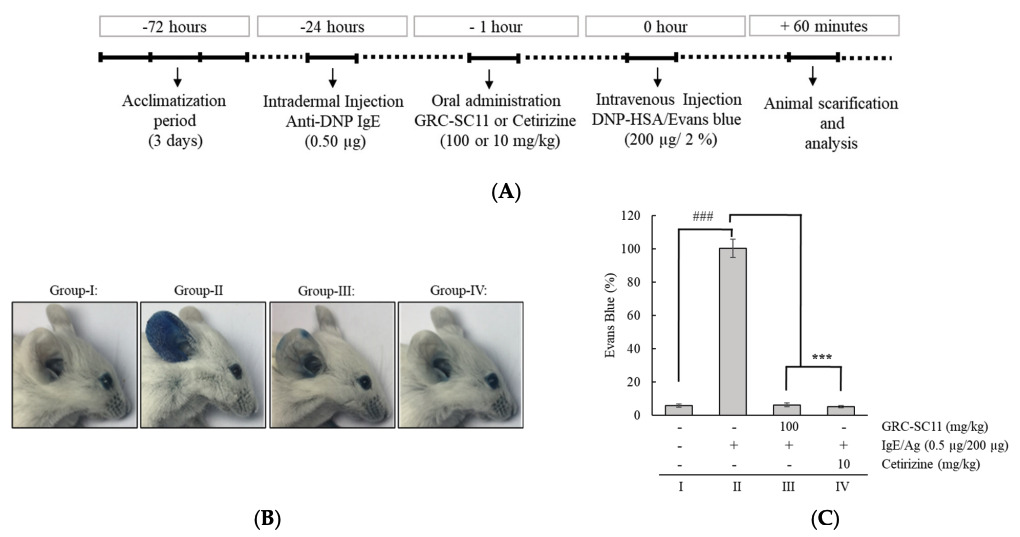Passive Cutaneous Anaphylaxis (PCA) Model
Passive cutaneous anaphylaxis (PCA), as an animal model for Type I allergy, is useful in drug testing studies to evaluate inhibition of inflammation efficacy. Creative Biolabs provides services including in vivo and in vitro testing for clients worldwide to facilitate your brilliant studies. According to your unique requirements, our scientists will work with you to assist you from initial study design to final reporting and analysis of your data to provide you with reliable, reproducible results at most favorable prices.
Type I Hypersensitivity Reaction
Type I hypersensitive reaction is defined as a severe, life-burdening, or systemic hypersensitivity reaction mediated by immunoglobulin E (IgE). Mast cells and basophils play a key role in eliciting this IgE-mediated allergenic reaction. Located at epithelial surfaces such as the lung and intestine, mast cells become one of the first activators of the inflammatory response. Due to a specific IgE receptor, which is called ‘FcεR1', displayed on their surface, mast cells show a high affinity for IgE. Therefore, as the IgE-multivalent allergen complex binds to the FcεR1 receptor, IgE receptor signaling pathway in mast cells is activated, leading to the overproduction of inflammatory mediators that trigger allergenic reactions. In normal conditions, the mast cells have released mediators such as histamine serine proteases and β-hexosaminidase in their cytoplasmic granules.
 Fig. 1 Effect of GRC-SC11 on the IgE/Ag-stimulated passive cutaneous anaphylaxis (PCA) BALB/c mice model. 1
Fig. 1 Effect of GRC-SC11 on the IgE/Ag-stimulated passive cutaneous anaphylaxis (PCA) BALB/c mice model. 1
Passive Cutaneous Anaphylaxis (PCA)
Passive cutaneous anaphylaxis (PCA) is an animal model for inflammatory reactions in Type I allergy. Conventionally, passive cutaneous anaphylaxis is induced by intradermally injecting an exogenous IgE antibody specific against an antigen into one ear of each mouse. One day after IgE administration, we injected a DNP-HSA-Evans blue mixture into tail veins of each mouse to induce a systemic allergic reaction. As a result, the vascular permeability is increased and allows for leakage of the albumin-bound dye, producing a blue spot at the site of intradermal injection. Subsequently, the IgE/Ag-sensitized mouse ears swelled and turned blue. Two hours after the Ag challenge, the mice were sacrificed and the treated ear was excised to measure the amount of dye that had extravasated in response to the Ag. The dye was extracted from the ear with formamide at 63°C overnight and quantified by measuring dye absorbance at 620 nm. This way, quantification of these allergenic reactions can be achieved easily.
Creative Biolabs is able to provide assessments including but not limited to:
- Body Weight
- Ear Thickness
- PK/PD Blood Collections
- Dye Leakage
- Cytokine/Chemokine Analysis
- Immunohistochemistry
Meanwhile, in order to meet our customers' specific requirements and their various research objectives, Creative Biolabs also offers other rodent inflammatory & immunological disease models listed as follows that you might be interested in:
- Carrageenan Air Pouch Model
- Carrageenan-Induced Paw Edema Model
- Imiquimod (IMQ)-Induced Psoriasis Rodent Model
- Chemical-Induced Rodent Contact Hypersensitivity Model
- Delayed Type Hypersensitivity (DTH) Rodent Model
- Adjuvant-Induced Arthritis (AIA) Rodent Model
- Collagen-Induced Arthritis (CIA) Rodent Model
- Collagen Antibody-Induced Arthritis (CAIA) Model
- Cecum Ligation and Puncture (CLP)-Induced Sepsis Model
- LPS-Induced Rodent Sepsis Model
- Spontaneous Systemic Lupus Erythematosus (SLE) Mouse Models
- Induced Models of Systemic Lupus Erythematosus
Creative Biolabs has a group of experts who are experienced in validating animal models quickly from the literature. Therefore, besides the model described above, Creative Biolabs can offer many other inflammatory rodent models to meet your various requirements. So please contact us or directly send us an inquiry if you are interested in any of these services.
Reference
- Phull, Abdul-Rehman et al. "Lactic Acid Bacteria Fermented Cordyceps militaris(GRC-SC11) Suppresses IgE Mediated Mast Cell Activation and Type I Hypersensitive Allergic Murine Model." Nutrients vol. 13,11 3849. 28 Oct. 2021, doi:10.3390/nu13113849. Distributed under Open Access license CC BY 4.0, without modification.
For Research Use Only.
